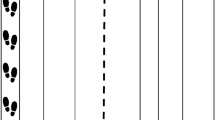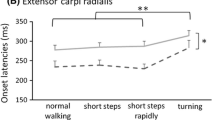Abstract
Individuals living with multiple sclerosis frequently have impairments in mobility. These impairments are more pronounced when they engage in a cognitively demanding mobility tasks (i.e., walking and talking, obstacle clearance, etc). Based in part on the attentional capacity model of movement, these impairments are suggested to result from greater attentional demands. Yet, this model has not been directly tested in neurological populations. The objective of the study was to determine whether individuals with multiple sclerosis have greater attentional cost of movement across a range of tasks. This study tested probe reaction times of 20 individuals with multiple sclerosis and 26 healthy controls in five different movement tasks. The tasks were specifically chosen to challenge the perceptual–motor system based on variations in static and dynamic balance requirements. Participants were asked to verbally respond as quickly as possible to randomly presented audio probes during motor performance. Task order was randomized, and average probe reaction time was calculated for each task. The results showed tasks requiring dynamic stability had greater probe reaction times in both healthy controls and individuals with multiple sclerosis. Furthermore, individuals with multiple sclerosis had longer probe reaction times across all tasks compared to healthy controls. Yet, there was no relationship between probe reaction times and performance during a complex walking scenario. The results indicate the attentional capacity model may be inadequate to explain cognitive–motor interaction in people with multiple sclerosis. Future studies should address the theoretical framework of cognitive–motor interaction, which may influence the design of interventions aimed at improving performance in individuals with MS.



Similar content being viewed by others
References
Abernethy B, Hanna A, Plooy A (2002) The attentional demands of preferred and non-preferred gait patterns. Gait Posture 15(3):256–265
Al-Yahya E, Dawes H, Smith L, Dennis A, Howells K, Cockburn J (2011) Cognitive motor interference while walking: a systematic review and meta-analysis. Neurosci Biobehav Rev 35(3):715–728. https://doi.org/10.1016/j.neubiorev.2010.1008.1008 (Epub 2010 Sep 1015)
Benedict RH, Zivadinov R (2011) Risk factors for and management of cognitive dysfunction in multiple sclerosis. Nat Rev Neurol 7(6):332–342
Benedict RH, Holtzer R, Motl RW, Foley FW, Kaur S, Hojnacki D, Weinstock-Guttman B (2011) Upper and lower extremity motor function and cognitive impairment in multiple sclerosis. J Int Neuropsychol Soc 17(4):643–653
Bjartmar C, Trapp BD (2001) Axonal and neuronal degeneration in multiple sclerosis: mechanisms and functional consequences. Curr Opin Neurol 14(3):271–278
Camicioli R, Howieson D, Lehman S, Kaye J (1997) Talking while walking: the effect of a dual task in aging and Alzheimer’s disease. Neurology 48(4):955–958
de Jager CA, Budge MM, Clarke R (2003) Utility of TICS-M for the assessment of cognitive function in older adults. Int J Geriatr Psychiatry 18(4):318–324
Filippi M, Bar-Or A, Piehl F, Preziosa P, Solari A, Vukusic S, Rocca MA (2018) Multiple sclerosis. Nat Rev Dis Primers 4(43):1–27
Hauser SL, Oksenberg JR (2006) The neurobiology of multiple sclerosis: genes, inflammation, and neurodegeneration. Neuron 52(1):61–76
Hemmer B, Nessler S, Zhou D, Kieseier B, Hartung HP (2006) Immunopathogenesis and immunotherapy of multiple sclerosis. Nat Clin Pract Neurol 2(4):201–211
Hernandez ME, Holtzer R, Chaparro G, Jean K, Balto JM, Sandroff BM, Izzetoglu M, Motl RW (2016) Brain activation changes during locomotion in middle-aged to older adults with multiple sclerosis. J Neurol Sci 370:277–283
Kahneman D (1973) Attention and effort. Prentice-Hall Inc, Englewood Cliffs
Kahya M, Wood TA, Sosnoff JJ, Devos H (2018) Increased postural demand is associated with greater cognitive workload in healthy young adults: a pupillometry study. Front Hum Neurosci 12:288
Kurosawa K (1994) Effects of various walking speeds on probe reaction time during treadmill walking. Percept Mot Skills 78(3 Pt 1):768–770
Lajoie Y, Teasdale N, Bard C, Fleury M (1993) Attentional demands for static and dynamic equilibrium. Exp Brain Res 97(1):139–144
Lajoie Y, Teasdale N, Bard C, Fleury M (1996) Upright standing and gait: are there changes in attentional requirements related to normal aging?. Exp Aging Res 22(2):185–198
Larocca NG (2011) Impact of walking impairment in multiple sclerosis: perspectives of patients and care partners. Patient 4(3):189–201
Learmonth YC, Ensari I, Motl RW (2017) Cognitive motor interference in multiple sclerosis: insights from a systematic quantitative review. Arch Phys Med Rehabil 98(6):1229–1240
Mainero C, Caramia F, Pozzilli C, Pisani A, Pestalozza I, Borriello G, Bozzao L, Pantano P (2004) fMRI evidence of brain reorganization during attention and memory tasks in multiple sclerosis. Neuroimage 21(3):858–867
Mazaheri M, Roerdink M, Bood RJ, Duysens J, Beek PJ, Peper CLE (2014) Attentional costs of visually guided walking: effects of age, executive function and stepping-task demands. Gait Posture 40(1):182–186
Plummer P, Eskes G, Wallace S, Giuffrida C, Fraas M, Campbell G, Clifton K, Skidmore ER (2013) Cognitive-motor interference during functional mobility after stroke: state of the science and implications for future research. Arch Phys Med Rehabil 94(12):2565 e2566–2574 e2566
Ratzker P, Feldman J, Scheinberg L, LaRocca N, Smith C, Giesser B, Aisen M (1997) Self-assessment of nuerologic impairment in mulitiple sclerosis. Neurorehabil Neural Repair 11(4):207–211
Reitan R (1958) Validity of the trail making test as an indicator of organic brain damage. Percept Mot Skills 8:271–276
Slobounov SM, Slobounova ES, Newell KM (1997) Virtual time-to-collision and human postural control. J Motor Behav 29(3):263–281
Sosnoff JJ, Boes MK, Sandroff BM, Socie MJ, Pula JH, Motl RW (2011) Walking and thinking in persons with multiple sclerosis who vary in disability. Arch Phys Med Rehabil 92(12):2028–2033. https://doi.org/10.1016/j.apmr.2011.2007.2004
Sosnoff JJ, Socie MJ, Sandroff BM, Suh Y, Balantrapu S, Pula JH, Motl RW (2014) Mobility and cognitive correlates of dual task cost of walking in persons with multiple sclerosis. Disabil Rehabil 36:1464–5165 (Electronic)
Van Schependom J, D’Hooghe B, Cleynhens MK, D’Hooge M, Haelewyck MC, De Keyser J, Nagels G (2014) The symbol digit modalities test as sentinel test for cognitive impairment in multiple sclerosis. Eur J Neurol 21(9):1219–1225, e1271–1212
Wajda DA, Sosnoff JJ (2015) Cognitive-motor interference in multiple sclerosis: a systematic review of evidence, correlates, and consequences. Biomed Res Int 2015:720856. https://doi.org/10.1155/2015/720856. (Epub 722015 Mar 720859)
Woollacott M, Shumway-Cook A (2002) Attention and the control of posture and gait: a review of an emerging area of research. Gait Posture 16(1):1–14
Yogev-Seligmann G, Hausdorff JM, Giladi N (2012) Do we always prioritize balance when walking? Towards an integrated model of task prioritization. Mov Disord 27(6):765–770
Author information
Authors and Affiliations
Corresponding author
Additional information
Publisher’s Note
Springer Nature remains neutral with regard to jurisdictional claims in published maps and institutional affiliations.
Rights and permissions
About this article
Cite this article
Wajda, D.A., Wood, T.A. & Sosnoff, J.J. The attentional cost of movement in multiple sclerosis. J Neural Transm 126, 577–583 (2019). https://doi.org/10.1007/s00702-019-01990-5
Received:
Accepted:
Published:
Issue Date:
DOI: https://doi.org/10.1007/s00702-019-01990-5




